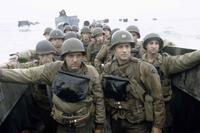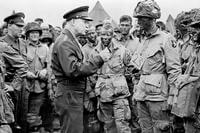NORMANDY, France -- When we think of Catholic saints, most people probably envision Saint Patrick or Mother Teresa. The image of a tough-as-nails World War II-era paratrooper is probably the furthest thing from their minds -- for now.
On the morning of June 6, 1944, the 508th Parachute Infantry Regiment of the 82nd Airborne Division parachuted into Gueutteville, near Picauville, France, as part of the D-Day invasion. The 508th's mission, along with the rest of the 82nd, was to capture Sainte-Mère-Église, secure crossings at the Merderet River near La Fière and Chef-du-Pont, and establish a defensive line for the Allied landings on the beaches. The 82nd would face some of the fiercest, bloodiest small-unit battles of the entire war.
Among the paratroopers jumping in that morning was their Catholic chaplain, Capt. (and Friar) Ignatius Maternowski. A native of Holyoke, Massachusetts, Maternowski was 32 years old and every bit a paratrooper of the 82nd Airborne. He wasn't afraid to correct troopers who took the Lord's name in vain and was known to tell those speaking ill of the church or confession to "put on some boxing gloves."
Most importantly, as a chaplain, he didn't have to parachute behind enemy lines that night -- but he was determined to be there for the sake of the souls in his unit. It turned out that he cared just as much for the souls his unit might take on the battlefield. It would ultimately lead to his tragic death in the combat zone and, ultimately, calls for his canonization as a saint.

Ignatius began his religious education in 1931 and became ordained as a friar in 1938. He preached for three years before the Japanese surprise attack on Pearl Harbor. Filled with the desire to serve and minister to the soldiers who would put their lives at risk, he asked permission to join the Army as a chaplain. He entered the service in 1942 and volunteered to join the paratroopers. By January 1944, he was in England, training for Operation Overlord with the rest of the 82nd Airborne.
When D-Day finally came, Maternowski held a mass, gave his soldiers a general absolution and boarded a C-47 Skytrain with the rest of the more than 13,000 paratroopers and glider infantry. Upon landing in Normandy, he happened upon one of the gliders that crashed near Picauville. While helping the survivors, he realized there would be many, many more wounded in need of aid that day.
With the help of a medic, he moved the wounded to a nearby cafe and grocer in the town, but his makeshift aid station was soon overflowing with the dead and dying. He decided the best hope for saving these lives was to reach out to the enemy. Unarmed anyway, he took off his helmet and attached it to his belt, then walked down the street amid the fighting with only his chaplain's insignia, a red cross armband and his faith to protect him. He walked into the German positions and asked to speak with their ranking medical officer.

Maternowski convinced the German doctor to walk with him to the American aid station and see the situation for himself. As they walked, the chaplain suggested creating a combined aid station in a house at the end of the street, where both sides could be seen and treated. Once the officer saw the dire situation of the U.S. troops, he said he would need to return to the German lines. Maternowski escorted him back to his position and then began walking back to his own.
As he walked the dangerous street for the fourth time that day, he was shot in the back and killed by a German sniper. The Americans would be unable to recover his body for days, but once they did, they laid him to rest at Utah Beach. Today, the site where he was killed is memorialized and meticulously maintained by the local residents of Picauville, many of whom are too young to remember World War II.

Maternowski's remains were ultimately returned to Massachusetts, but he was immortalized in 2021 with a stained-glass window depicting his image, his faith and his service at La Petite Chapelle de Cauquigny, near where some of the heaviest fighting for the town took place. He was the only American chaplain killed in action on D-Day, but some 100 chaplains would give their lives during World War II, the third-highest casualty rate behind the infantry and Army Air Forces.
In 2019, the Franciscan Friars Conventual of the Our Lady of the Angels Province began promoting Fr. Ignatius Maternowski's cause for canonization. It's the first step in a long process toward sainthood.
Want to Learn More About Military Life?
Whether you're thinking of joining the military, looking for post-military careers or keeping up with military life and benefits, Military.com has you covered. Subscribe to Military.com to have military news, updates and resources delivered directly to your inbox.

























